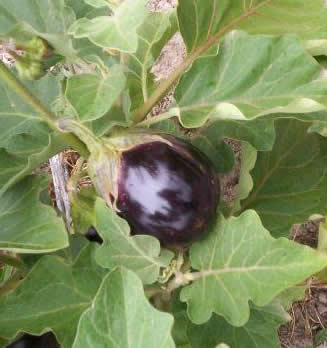
Brinjal (Solanum melongena L.) is one of the most common vegetables grown throughout the country for its purple, green or white pendulous fruit. It is a member of the Solanaceae family and is closely related to tomato and potato. Aubergine is the British name for brinjal and in United States, Australia and Canada, it is known by the name eggplant, because fruits of the earlier cultivars resembled eggs of goose or hen.
Brinjal is an erect annual plant, often spiny, with large, coarsely lobed fuzzy leaves, 10-20 cm long and 5-10 cm broad. The plants usually grow 45 to 60 cm high and bears long to oval shaped, purple or greenish fruits. Flowers are white to purple, with five-lobed corolla and yellow stamens. The fruit is a fleshy berry, containing numerous small, soft seeds.
Origin & distribution
Brinjal is a native of India and Sri Lanka. The ancestors of brinjal grew wild in south India and were in cultivation in southern and eastern Asian countries since prehistoric times. Although it has a long and rich history, brinjal did not always hold the revered place in food culture that it does today. At one time brinjal had a bitter and inauspicious reputation of being able to cause insanity, leprosy and cancer, and it was even believed to be poisonous; and hence was used more as a garden plant than as a food in many parts of the world. But it was only in the 18th century, after the evolution of less bitter varieties, brinjal lose its bitter taste and bitter reputation to gain its now esteemed place in the cuisines. Today, Italy, Turkey, Egypt, China and Japan are the leading growers of brinjal. In India, it is a popular vegetable crop of southern states and is also cultivated in certain parts of Maharashtra, Gujarat and Uttar Pradesh.
